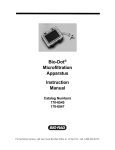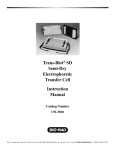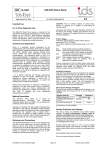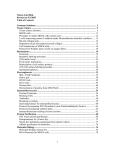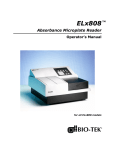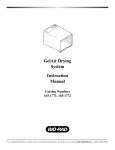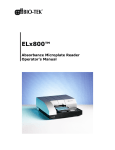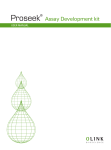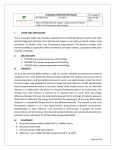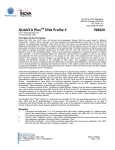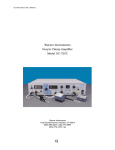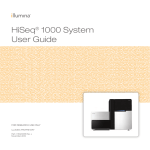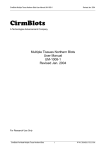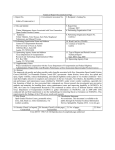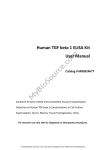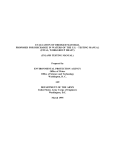Download Bio-Dot® SF Microfiltration Apparatus Instruction Manual
Transcript
Bio-Dot® SF Microfiltration Apparatus Instruction Manual Catalog Number 170-6542 170-6543 For technical ser vice call your local Bio-Rad office or in the U.S., call 1-800-4BIORAD (1-800-424-6723) Table of Contents Page Section 1 Introduction ..................................................................................1 1.1 Specifications............................................................................................1 Section 2 Special Handling and Features ..................................................1 2.1 2.2 Autoclaving ..............................................................................................1 Chemical Stability ....................................................................................1 Section 3 Bio-Dot SF Assembly ..................................................................3 3.1 3.2 Assembly ..................................................................................................3 Helpful Hints ............................................................................................5 Section 4 Protein Slot Blotting ....................................................................6 4.1 4.2 General Recommendations ......................................................................6 Immunoassay Procedure ..........................................................................6 Section 5 DNA Slot Blotting ........................................................................7 Section 6 RNA Slot Blotting ........................................................................8 6.1 6.2 Alkaline RNA Denaturation and Fixation ..................................................8 Glyoxal RNA Denaturation and Fixation ..................................................9 Section 7 Hybridization Protocols for Nucleic Acids ..............................10 7.1 7.2 7.3 7.4 Probe Recommendations ......................................................................10 Hybridization Protocols for DNA or RNA Bound to Nitrocellulose or Zeta-Probe® Membrane ..............................................10 Hybridization Protocols for RNA Probes ................................................12 Probe Stripping and Rehybridization ......................................................13 Section 8 Solutions for Protein Applications ..........................................13 8.1 8.2 Solutions for Nitrocellulose Membrane ..................................................13 Solutions for Zeta-Probe Membrane ......................................................14 Section 9 Solutions for Nucleic Acid Applications ..................................15 Section 10 Troubleshooting Guide ..............................................................16 Section 11 References ..................................................................................19 Section 12 Legal Notices ..............................................................................19 Section 13 Ordering Information ................................................................21 Section 1 Introduction The Bio-Dot SF blotting apparatus has an evenly spaced, slot shaped sample template for easy slot blot sample comparisons. Because the Bio-Dot SF apparatus focuses the applied samples in a thin line instead of a circle, this slot format makes it easy to use a densitometer to quantitate results. The Bio-Dot SF apparatus is provided as a complete unit, or as a modular addition to the Bio-Dot microfiltration system. Conversion of the Bio-Dot SF apparatus to the Bio-Dot blotting apparatus is accomplished by purchasing the Bio-Dot module, which provides the 96-well sample template. The Bio-Dot SF slot format sample template has 48 wells with dimensions of 7 mm x 0.75 mm. The wells are arranged in 8 rows and 6 columns. Sample can be applied using a standard pipet or with an 8-channel pipet. The material used in the construction of the Bio-Dot SF blotting apparatus can withstand rigorous sterilization and cleanup procedures. The Bio-Dot SF apparatus can be repeatedly autoclaved, and is resistant to many chemicals, including acids, bases, and ethanol. 1.1 Specifications Materials Bio-Dot SF apparatus Bio-Dot SF gasket Stopcock Shipping weight Overall size Membrane size Autoclaving Chemical compatibility Molded polysulfone Silicone rubber Teflon 600 grams 13 x 15 x 6 cm 12 x 9 cm sheet 15 minutes at 250°F (121°C) with a 1 minute fast exhaust The Bio-Dot SF apparatus can be used with 100% alcohol solutions and concentrated alkali or acid solutions. It cannot be used with aromatic or chlorinated hydrocarbons. (See Table 1) Section 2 Special Handling and Features The Bio-Dot apparatus withstands autoclave temperatures for sterilization, as well as cleaning with alcohols, acids, and base solutions. 2.1 Autoclaving The Tygon tubing and flow valve cannot be autoclaved. All other components of the apparatus withstand the autoclave treatment. After repeated autoclaving (~25 cycles) the silicone rubber gasket may need replacing. The autoclave conditions that should be used are a maximum sterilization temperature of 250°F (121°C) for 15 minutes, followed by a 1 minute fast exhaust. Higher temperatures or increased exposure times will significantly reduce the life of the apparatus. Do not autoclave the unit with the thumbscrews tightened, as this may cause the unit to warp during exposure to the elevated temperatures. 2.2 Chemical Stability The apparatus is stable in both acid and base solutions. It is stable in all concentrations of alcohol solutions. Both of these features allow rapid cleanup and sterilization of the apparatus and gaskets. The unit is not compatible with polar, aromatic, or chlorinated hydrocarbons, esters, and ketones. These solvents will cause degradation of the plastic. See Table 1 for list of chemical stability. For color development in the apparatus, the unit is compatible with both the methanol 1 used in the horseradish peroxidase (HRP) color development systems and the low concentration of DMF used to solubilize the alkaline phosphatase (AP) color development reagents. However, high concentrations of DMF will attack the plastic. Also, the unit is completely compatible with the low concentrations of diethyl pyrocarbonate (DEPC) used as an alternative to autoclaving for elimination of RNase activity. Table 1. Chemical Compatibility Chemicals compatible with Bio-Dot SF apparatus Hydrochloric acid Methanol Sulfuric acid Ethanol Phosphoric acid Butanol Glacial acetic acid Isopropanol Sodium hydroxide Formaldehyde Potassium hydroxide Hydrogen peroxide Ammonium hydroxide Ethylene glycol Heptane 5% acetone in H2O Nitric acid Chemicals that will attack polysulfone Ethyl acetate Toluene Butyl acetate Benzene Acetone Methyl ethyl ketone Chloroform Methylene chloride Trichloroacetic acid 2 Section 3 Bio-Dot SF Assembly 3.1 Assembly 1. Clean and dry the Bio-Dot SF apparatus and gasket prior to assembly. 2. Place the gasket support plate into position in the vacuum manifold. (There is only one way to slide the plate into the manifold.) Place the sealing gasket on top of the vacuum manifold. Sample template with attached sealing screws Membrane Filter paper (3 sheets) Sealing gasket Gasket support plate Vacuum manifold Tubing and flow valve Fig.1. Diagram of proper Bio-Dot SF apparatus assembly. 3. Moisten three sheets of Bio-Dot SF filter paper (catalog number 162–0161) in wetting solution. Use the same solution that is used to prewet the membrane (step 4). Place the three sheets onto the membrane support. The filter paper is precut to fit inside the sealing gasket. Use of Bio-Dot SF filter paper ensures high quality results and eliminates the chance of cross-well contamination. 4. Always use forceps or wear gloves when handling membranes. Prewet the nitrocellulose or Zeta-Probe® membrane by slowly sliding it at a 45° angle into wetting solution. Nitrocellulose is wetted in 6x sodium, sodium citrate (SSC) for nucleic acid applications, and in Tris-buffered saline (TBS) for protein binding. Zeta-Probe membrane is wetted in distilled water. See Sections 9 and 10 for solution preparation. A 10 minute soak is recommended for complete wetting of the membrane to ensure proper drainage of solutions. Remove the membrane from the wetting solution. Let the excess liquid drain from the membrane. (Touching the membrane to a sheet of filter paper is a simple method for removing excess buffer.) Lay the membrane on the filter paper in the apparatus so it extends over the edges of the filter paper. For the best slot blot results, use membrane sheets that have been precut to a 9 x 12 cm size (catalog number 162–0117 for nitrocellulose, 162-0153 for Zeta-Probe membrane). In all cases, the membrane should not extend beyond the edge of the gasket after the Bio-Dot SF apparatus is assembled. Remove any air bubbles trapped between the membrane and the filter paper. Note: PVDF membrane is not recommended. 3 5. Place the sample template on top of the membrane. The guide pins ensure that the template will be properly aligned. Finger-tighten the four screws. When tightening the screws, use a diagonal crossing pattern to ensure uniform application of pressure on the membrane surface (see Figure 2). Fig. 2. Diagonal crossing pattern for tightening screws in the Bio-Dot apparatus. 6. Attach a vacuum source (house vacuum or vacuum pump) to the flow valve with a waste trap set up and positioned between the vacuum outlet and flow valve. Turn on the vacuum and set the 3-way valve to apply vacuum to the apparatus (flow valve setting one, Figure 3). 7. With vacuum applied, repeat the tightening process using the diagonal crossing pattern. Tightening while vacuum is applied ensures a tight seal, preventing cross contamination between slots. Failure to tighten screws during application of vacuum prior to starting the assay may lead to leaking between the wells. 8. Adjust the flow valve so that the vacuum manifold is open to air (flow valve setting two, Figure 3). Apply 100 µl to all the sample wells. Use of an 8-channel pipet and buffer reservoirs (see Section 13 for information) will simplify the process of adding solutions to the Bio-Dot SF apparatus. Addition of buffer is necessary to rehydrate the membrane following the vacuum procedure in step 7. If this step is not performed prior to applying samples, assay results will show halos or weak detection signal. 9. Gently remove the buffer from the wells by vacuum (flow valve setting three, Figure 3). Watch the sample wells. As soon as the buffer solution drains from all the wells, adjust the flow valve so that the unit is exposed to air and disconnect the vacuum. At this point, the unit is ready for sample application. 4 Flow Valve Setting 1. The vacuum manifold is exposed to the vacuum source only. Use for applying vacuum to the Bio-Dot SF apparatus. Air Vacuum Bio-Dot Flow Valve Setting 2. The manifold is exposed to air. Use for gravity filtration procedures. Air Bio-Dot Flow Valve Setting 3. The manifold is exposed to both air and the vacuum. Use this setting for gentle vacuum applications where the amount of vacuum is regulated by putting a finger over the port exposed to the atmosphere. Vacuum Air Bio-Dot Vacuum Fig. 3. Optional settings for the 3-way flow valve to obtain optimal performance from the Bio-Dot SF apparatus. 3.2 Helpful Hints 1. During the assay, do not leave the vacuum on. This may dehydrate the membrane and may cause halos around the wells. Apply vacuum only until solutions are removed from the sample wells, then adjust the flow valve so that the unit is exposed to air and disconnect the vacuum source. 2. If some sample wells are not used in a particular assay, those wells must be closed off to insure proper vacuum to the wells in use. There are three ways to close off unused wells. One is to apply a 3% gelatin solution to those wells. Gelatin will clog the membrane and cut off the vacuum flow to the clogged wells. The second method is to cover the unused portion of the apparatus with tape to prevent air from moving through those wells. The third method is to add buffer to the empty wells at each step instead of sample or wash solutions. 3. Any particulate in samples or solutions will block the membrane and restrict flow of solutions through the membrane. For best results, filter or centrifuge samples to remove particulate matter. 4. Check the wells after sample has been applied to insure that there are no air bubbles in the wells. Air bubbles will prevent the sample from binding to the membrane. Air bubbles may be removed by pipetting the liquid in the well up and down. 5. Proper positioning of the flow valve relative to the level of the apparatus is important for proper drainage. The speed of filtration is determined by the difference in hydrostatic pressure between the fluid in the sample wells and the opening of the flow valve which is exposed to air. If the opening of the flow valve is above the level of the sample wells very little drainage will occur. When the flow valve is positioned where it is at a level below the sample wells proper drainage will occur during filtration applications. 6. The recommended sample loading volume is at least 200 µl. If sample volumes of less than 200 µl are loaded, they must be carefully applied to the center of the well. Applying the solution on one side of the well results in unequal distribution of sample. This results in unevenly shaped bands, leading to distorted densitometer readings. 5 7. The Bio-Dot SF apparatus is designed for use with an 8-channel pipet allowing eight sample or wash solutions to be quickly and easily applied to one row at a time. 8. The best method for removing the blotted membrane from the Bio-Dot SF apparatus is to leave the vacuum on following the wash step. With the vacuum applied, loosen the screws and remove the sample template. Next, turn off the vacuum and remove the membrane. Section 4 Protein Slot Blotting 4.1 General Recommendations 1. Solution Volume. The liquid in the incubation vessel should be least 0.25 cm deep to ensure the membrane is completely submerged during incubation. There should be at least 0.5 ml of reagent per cm2 of membrane. Larger volumes may be used for convenience. 2. Handling the mMembrane. Wear clean plastic gloves or use forceps to avoid fingerprints on the membrane. 3. Temperature. All steps are performed at room temperature (22–25°C). 4. Incubation Vessels. Incubation vessels may be made of plastic or glass. However, since avidin binds to unsiliconized glass, plastic or siliconized glass vessels should be used whenever biotin-avidin systems are employed for detection. 5. Membrane Incubation. Agitation with a rotating shaker platform enhances incubation efficiency. If a shaker platform is not available, hand mixing every few minutes and extended incubation periods will suffice. 6. Detection. It is best to incubate only one membrane per vessel. Should it become necessary to use more than one membrane per incubation vessel, calculate the solution volume based on the membrane surface area, not the vessel size. 4.2 Immunoassay Procedure Detailed instructions, including a comprehensive troubleshooting guide, for performing immunoassays are given in the Immun-Blot® instruction manuals. 1. Assemble the Bio-Dot SF apparatus as described in Section 3.1. Prewet the membrane prior to placing it in the apparatus. Nitrocellulose membranes are prewetted in TBS; Zeta-Probe membrane is prewetted in distilled water (see Section 10 for solution preparation). Make sure that all the screws have been tightened under vacuum to ensure that there will not be any cross-well contamination. 2. Rehydrate the membrane to ensure uniform binding of the antigen. Use 100 µl TBS per well for nitrocellulose membranes. Use 100 µl distilled water per well for the Zeta-Probe membrane. 3. Adjust the flow valve so that the vacuum chamber is open to air (flow valve setting 2, Figure 3). Fill the appropriate wells with antigen (protein) solution, applying 50–500 µl per well. The recommended sample loading volume is at least 200 µl. If less than 200 µl is applied, the sample must be carefully applied to the center of the well. Applying the solution on one side of the well results in unequal distribution of sample. This results in unevenly shaped bands, leading to distorted densitometer readings. 6 Note: The solution applied should be free of insoluble particles to avoid clogging of wells. 4. Allow the entire sample to filter through the membrane by gentle vacuum. Make sure that the flow valve is positioned at a level below the sample wells to ensure proper drainage during filtration applications. Slow, gentle filtration is necessary for quantitative antigen binding. Each well should be filled with the same volume of sample solution to ensure homogeneous filtration of all sample wells. 5. Wash each sample well with at least 200 µl of TBS. Pull the wash liquid through by applying gentle vacuum (flow valve setting 3, Figure 3). 6. After the wells have completely drained, remove the membrane from the apparatus. The best method for removing the membrane from the Bio-Dot SF apparatus is to leave the vacuum on following the wash step. With the vacuum applied, loosen the screws and remove the sample template. Next, turn off the vacuum and remove the membrane. 7. Place the membrane in the blocking solution. The blocking solution used is dependent on the type of membrane used. Nitrocellulose is blocked in gelatin, BSA, or non fat dry milk. ZetaProbe membrane is blocked in either nonfat dry milk or gelatin and 1-methyl-2-pryrrolidinone (MPO) (see Section 10, solution preparation). All solution volumes should be at least 0.5 ml/cm2 of membrane. Larger volumes may be used for convenience. Gently agitate the solution using a shaker platform. Continue the incubation for 30 minutes to 1 hour. 8. Remove the membrane from the blocking solution and transfer to a dish or tray containing Tween, Tris-buffered saline (TTBS). Wash for 5 minutes with gentle agitation. Decant the wash solution. Repeat the wash step. 9. Transfer the membrane from the TTBS wash solution to a dish or tray containing the primary antibody solution. Incubate 1 to 2 hours with gentle agitation. Overnight incubation may be desirable, since longer incubation periods may increase the sensitivity of detection in some situations. 10. Remove unbound primary antibody by washing the membrane in TTBS for 5 minutes with gentle agitation. Decant the wash solution and repeat the wash step. 11. Transfer the membrane to the secondary antibody conjugate solution. 12. Transfer the membrane from the conjugate solution and wash it in TTBS for 5 minutes. Decant the buffer and repeat the wash step. Prior to color development, do a final 5 minute wash in TBS to remove residual Tween 20 detergent from the membrane surface. 13. Do the color development reaction according to the Immun-Blot assay kit instruction manual. If performing autoradiography, remove the membrane, dry it on a filter paper, wrap it with plastic wrap, and expose it to X-ray film. Section 5 DNA Slot Blotting This section gives protocols for DNA slot blotting. The alkaline blotting method, using Zeta-Probe membrane, and a more standard method for DNA blotting to nitrocellulose, are described. 1. The target DNA must be denatured prior to application to the membrane. When using the Zeta-Probe membrane, denature the DNA sample by addition of NaOH and EDTA solution to final concentrations of 0.4 M NaOH, 10 mM EDTA. Heat the sample to 100°C for 10 minutes to ensure complete denaturation. When applying DNA to a nitrocellulose membrane, denature the DNA in the same manner. The DNA must then be neutralized by adding an equal volume of cold 2 M ammonium acetate, pH 7.0 to the target DNA solution. Leave DNA on ice while preparing Bio-Dot. 7 2. Prewet the membrane by placing the membrane gently at a 45° angle into a tray of the wetting solution. Always wear gloves when handling blotting membranes. Nitrocellulose membranes should be wetted in 6x SSC (see Section 9 for recipes); Zeta-Probe membranes should be wetted in distilled water. 3. Assemble the Bio-Dot SF apparatus according to the instructions in Section 3.1. Apply the vacuum and then retighten the screws that hold the apparatus together. Rehydrate the membrane with 500 µl Tris-EDTA (TE) or H2O as described in Section 3.1. At this point, the unit is ready for sample application. 4. Samples and wash solutions should be applied with a standard pipet or an 8-channel pipet with the vacuum off and the flow valve open. Apply the denatured DNA in a 50–500 µl sample volume. The recommended sample loading volume is at least 200 µl. If sample volumes of less than 200 µl are applied, they must be very carefully applied to the center of the well. Applying the solution on one side of the well results in unequal distribution of DNA. This may result in unevenly shaped bands, leading to distorted densitometer readings. Fill all wells with the same volume to ensure homogeneous filration. 5. The sample may be pulled through by applying a gentle vacuum, or by gravity filtration. Note: A method for applying gentle vacuum to the apparatus is to adjust the flow valve to valve setting 3. Use a finger to cover the valve port exposed to air. The amount of vacuum reaching the manifold will be regulated by the pressure of your finger on the valve. 6. After the sample has filtered through, add 500 µl 0.4 M NaOH to each well for Zeta-Probe membrane, or 2x SSC for nitrocellulose. Apply the vacuum by setting the 3-way valve to setting 1 until the sample wells are empty. 7. Disassemble the Bio-Dot SF apparatus. Remove the blotted membrane and rinse it in 2x SSC. Allow the membrane to air dry. The Zeta-Probe membrane is ready for hybridization immediately after air drying. If hybridization is not to be undertaken within 2 days, then vacuum bake the blotted Zeta-Probe membrane at 80°C for 30 minutes. Nitrocellulose membranes must be baked under vacuum for 2 hours at 80°C before hybridization. The Zeta-Probe membrane and nitrocellulose membranes can be stored dry between two pieces of filter paper in plastic bags at 23–25°C. Section 6 RNA Slot Blotting RNA must be denatured prior to application to Zeta-Probe® or nitrocellulose membranes to ensure optimal hybridization. Two protocols are presented for denaturing RNA samples. 6.1 Alkaline RNA Denaturation and Fixation 1. Always wear gloves when handling blotting membranes. Prewet the blotting membrane by placing it gently at a 45° angle into a tray of wetting solution. The Zeta-Probe membrane is wetted in distilled water; nitrocellulose is wetted in 6x SSC (see Section 9 for solution preparation). 2. Assemble the Bio-Dot SF apparatus according to the instructions in Section 3.1. Remember to apply the vacuum and then retighten the screws that hold the apparatus together. 3. Immediately before use, dissolve RNA samples in 500 µl of ice-cold 10 mM NaOH, 1 mM EDTA. 8 4. Samples and wash solutions may be applied with a standard pipet or an 8-channel pipet. Apply the denatured RNA, and pull the sample through by passive filtration or by applying a gentle vacuum. Note: A method for applying gentle vacuum to the apparatus is to adjust the flow valve to setting three. Use a finger to cover the valve port exposed to air. The amount of vacuum reaching the manifold will be regulated by the pressure of your finger on the valve. 5. Rinse all wells to wash any sample on the side of the wells through. Rinse with 500 µl cold 10 mM NaOH, 1 mM EDTA. Apply vacuum (flow valve setting 1, Figure 3) until the sample wells are dry. 6. Disassemble the Bio-Dot apparatus. Remove the blotted membrane and rinse it in 2x SSC, 0.1% sodium dodecyl sulfate (SDS). Nitrocellulose membranes must be baked under vacuum for 2 hours at 80°C before hybridization. The Zeta-Probe membrane is ready for hybridization. If hybridization is not to be undertaken within 2 days, then bake the Zeta-Probe membrane under vacuum for 30 minutes at 80°C. The Zeta-Probe membrane and nitrocellulose membranes can be stored dry between two pieces of filter paper in plastic bags at 23–25°C. 6.2 Glyoxal RNA Denaturation and Fixation 1. Prepare RNA samples to the following final concentrations: 50% dimethyl sulfoxide (DMSO) 10 mM NaH2PO4, pH 7.0 1 M glyoxal 2. Incubate the RNA for 1 hour at 50°C. Cool the samples on ice. 3. Pre-wet the blotting membrane by placing it gently at a 45° angle into a tray of wetting solution. Zeta-Probe membrane is wetted in distilled water, nitrocellulose is wetted in 6x SSC (see Section 9 for solution preparation). Always wear gloves when handling blotting membranes. 4. Assemble the Bio-Dot SF apparatus according to the instructions in Section 4.1. Remember to apply the vacuum and then retighten the screws that hold the apparatus together. 5. Samples and wash solutions may be applied with a standard pipet or an 8-channel pipet. Apply the denatured RNA, and pull the sample through by passive filtration or by applying a gentle vacuum. Note: A method for applying gentle vacuum to the apparatus is to adjust the flow valve to setting 3. Use a finger to cover the valve port exposed to air. The amount of vacuum reaching the manifold will be regulated by the pressure of your finger on the valve. 6. Rinse all wells to wash any sample on the side of the wells through. Rinse with 500 µl TE. Apply vacuum (flow valve setting 1, Figure 3) until the sample wells are dry. 7. Disassemble the Bio-Dot SF apparatus. Remove the blotted membrane. 8. Remove glyoxal adducts by pouring 20 mM Tris-HCl, pH 8.0, 1 mM EDTA heated to 95°C onto the membrane and agitating at room temperature until the solution cools. Alternatively, place the membrane in a vacuum oven at 80 °C for 1 hour for Zeta-Probe membrane, 2 hours for nitrocellulose, and omit step 8. 9. Nitrocellulose membranes must be baked under vacuum for 2 hours at 80°C before hybridization. If hybridization is not to be undertaken within 2 days, bake the Zeta-Probe membrane under vacuum for 30 minutes at 80°C. The Zeta-Probe membrane and nitrocellulose membranes can be stored dry between two pieces of filter paper in plastic bags at 23–25°C. 9 Section 7 Hybridization Protocols for Nucleic Acids 7.1 Probe Recommendations The specific activity, concentration, size range, and purity of the probe all have an important effect on signal-to-noise ratio during hybridization. For hybridization on Zeta-Probe membrane, the following is recommended: Probe specific activity: 108 cpm/µg probe Probe concentration in the hybridization mixture: 106 counts/ml (10–50 ng/ml) Probe length: 200–1,000 bp Optimal probe specific activity and concentration can vary according to available hybridization sites and exposure time. Alternative hybridization protocols are necessary when probe lengths vary outside this recommended range (Bio-Rad Laboratories 1987). Probe cleanup is essential to minimize background. Unincorporated nucleotides present after probe preparation contribute to hybridization background. The most effective cleanup method is by column chromatography. This can be done quickly and easily with the Bio-Spin® chromatography columns (Bio-Spin 6 columns, or Bio-Spin 30 columns, catalog number 7326004). After cleanup, denature double-stranded probes by heating to 95–100°C for 5 minutes. Then cool rapidly on ice. Use the probe as soon as possible after preparation. There are several hybridization protocols given in this section. All protocols are for using DNA probes to hybridize to either DNA or RNA. The 7% SDS hybridization protocol requires minimal prehybridization treatment and has a high signal strength and low background. Further references and techniques for hybridizing to the Zeta-Probe membrane may be found in the ZetaProbe membrane instruction manual. The final volume of hybridization solution is important in reducing background. For prehybridization and hybridization, use 150 µl solution/cm2 of membrane. For washes, use at least 350 µl/cm2 of membrane. 7.2 Hybridization Protocols for DNA or RNA Bound to Nitrocellulose or Zeta-Probe® Membrane Prehybridization 1. Place the blotted membrane inside a heat-sealable plastic bag. Seal three sides, leaving the top side open. 2. Pipet in the correct prehybridization solution for your application: For DNA or RNA Bound to Zeta-Probe Membrane For DNA Bound to Nitrocellulose For RNA Bound to Nitrocellulose 1 mM EDTA 7% SDS 0.5 M NaHPO4, pH 7.2 6x SSC 0.5% SDS 5x Denhardt’s solution 100 µg/ml denatured salmon sperm DNA 1 mM EDTA 50% formamide 5x SSC 1x Denhardt’s solution 50 mM NaHPO4, pH 6.5 250 µg/ml denatured salmon sperm DNA 10 The carrier DNA used with nitrocellulose must be denatured before adding it to the prehybridization solution. Heat the DNA at 100°C for 5 minutes and cool rapidly. 3. Seal the top of the bag and incubate. For DNA or RNA Bound to Zeta-Probe Membrane For DNA Bound to Nitrocellulose For RNA Bound to Nitrocellulose 5 minutes at 65°C 2–4 hours at 68°C 8–20 hours at 42°C Hybridization 1. Cut one corner of the plastic bag. Remove the prehybridization solution and replace it with a fresh batch of the same solution, except when binding RNA to nitrocellulose. In that case, add 10% dextran sulfate to the hybridization solution. Note: Formamide can also be used in the hybridization buffer to lower the incubation temperature when binding DNA to nitrocellulose or Zeta-Probe membrane (Maniatis et al. 1982, Casey and Davidson 1977). For alternative protocols, see the Zeta-Probe membrane instruction manual. 2. Add the denatured probe, remove all air bubbles and reseal the bag. Mix the contents of the bag. Hybridize with agitation. For DNA or RNA Bound to Zeta-Probe Membrane For DNA Bound to Nitrocellulose For RNA Bound to Nitrocellulose 4–24 hours at 65°C 4–24 hours at 68°C 4–24 hours at 42°C 3. Carefully remove the hybridization solution by cutting one corner. Remove hybridized membrane from the plastic bag. Note: Once hybridization has begun, do not let the membrane dry. Washes 1. Agitate the solutions when washing membranes. For DNA or RNA Bound to Zeta-Probe Membrane For DNA Bound to Nitrocellulose For RNA Bound to Nitrocellulose A. Wash 2 times for 30–60 minutes at 65°C in: 1 mM EDTA 40 mM NaHPO4, pH 7.2 5% SDS A. Rinse in: 2x SSC, 0.5% SDS in 2x SSC, 0.1% SDS A. Wash 4 times at room temperature for 5 minutes B. Wash 2 times for 30–60 minutes at 65°C in: 1 mM EDTA 40 mM NaHPO4, pH 7.2 1% SDS B. Wash at room temperature for 5 minutes in: 2x SSC, 0.5% SDS B. Wash 2 times at 50°C in: 0.1x SSC, 0.1% SDS C. Wash at 68°C 2 times for 1 hour each in: 0.1x SSC, 0.5% SDS 2. After washing, the blotted membrane is ready for autoradiography. If no further cycles of hybridization are to be done on the membrane, the membrane can be dried. When reprobing, do not allow the membrane to dry between hybridizations. Make the autoradiographic exposure with the moist membrane wrapped in plastic wrap or enclosed in a sealable plastic bag. Do not allow the wet membrane to come in contact with the film, because wet membranes will stick to the film, and any moisture on the film will cause black spots. 11 7.3 Hybridization Protocols for RNA Probes The following protocols are for RNA probes to DNA blots. Casey and Davidson (1977) contains protocols for RNA-RNA hybridizations. Prehybridization 1. Place the blotted membrane inside a heat-sealable plastic bag. Seal three sides, leaving the top side open. 2. Pipet in the prehybridization solution: For DNA Bound to Zeta-Probe Membrane For DNA Bound to Nitrocellulose 50% formamide 1.5x sodium, sodium phosphate, EDTA (SSPE) 1% SDS 0.5% nonfat dry milk 200 µg/ml carrier RNA 500 µg/ml denatured salmon sperm DNA 50% formamide 0.1% SDS 5x SSPE 5x Denhardt’s solution 200 µg/ml denatured salmon sperm DNA The carrier DNA must be denatured before adding it to the prehybridization solution by heating at 100°C for 5 minutes, followed by rapid cooling in ice. 3. Seal the bag and incubate. DNA Bound to Zeta-Probe Membrane DNA Bound to Nitrocellulose 30 minutes at 50°C 4 hours at 42°C Hybridization 1. Immediately before use, fragment and denature the probe and carrier DNA as follows. Add to the precipitated RNA probe 0.1 ml of yeast RNA (20 mg/ml), 0.5 ml of carrier DNA (10 mg/ml), and 0.6 ml of deionized formamide, mix thoroughly, and heat at 70°C for 5 minutes. 2. Cut one corner of the bag, remove the prehybridization solution, and replace it with hybridization solution. DNA Bound to Zeta-Probe Membrane DNA Bound to nitrocellulose 50% formamide 1.5x SSPE 1% SDS 0.5% nonfat dry milk 50% formamide 1x Denhardt’s solution 0.1% SDS 100 µg/ml denatured salmon sperm DNA 3. Add probe, then seal the open corner (taking care to exclude all air bubbles). Mix the contents of the bag thoroughly. Incubate at 50°C for 4–24 hours. Note: Once hybridization has begun, do not allow the membrane to dry. Washes 1. At the completion of hybridization, remove the membranes from their hybridization bags into 2x SSC. Rinse briefly, then wash them sequentially with agitation for 15 minutes at room temperature in the following solutions: • 2x SSC/0.1% SDS • 0.5x SSC/0.1% SDS • 0.1x SSC/0.1% SDS 2. For DNA bound to nitrocellulose membranes, it may be necessary to include an RNase treatment in the wash. Membranes are treated with 20 µg/ml RNase for 30 minutes at 37°C in 2x SSC (Johnson et al. 1984). 12 3. After washing, the blotted membranes are ready for autoradiography. If no further cycles of hybridization are to be done on the membrane, then the membrane can be dried. When reprobing do not allow the membrane to dry between hybridizations. Expose moist membranes between plastic wrap or enclosed in a sealable plastic bag. Do not allow a wet membrane to come in contact with the film, because wet membranes will stick to the film, and moisture on the film will cause black spots. Note: To increase the rate of hybridization, include 10% dextran sulfate (final concentration) in the hybridization solution (Maniatis et al. 1982). Prewarm hybridization solution to 50°C. Denature the probe and carrier as above. Special care must be taken to ensure uniform mixing of the denatured probe with the hybridization solution, since the solution is quite viscous at 50°C. 7.4 Probe Stripping and Rehybridization If reprobing is desired, do not allow the membrane to dry between hybridizations. The membrane should be stripped as soon as possible after autoradiography. 1. Wash 2 times, 20 minutes each, in a large volume of 0.1x SSC/0.5% SDS at 95°C. 2. Check membrane for removal of autoradiaography patterns by overnight exposure. Section 8 Solutions for Protein Applications 8.1 Solutions for Nitrocellulose Membrane Tris-Buffered Saline, 1x TBS, 2 L 20 mM Tris, pH 7.5 500 mM NaCl Dissolve 4.84 g Tris, 58.48 g NaCl in ddH2O. Adjust to pH 7.5 with HCl. Adjust the volume to 2 L with ddH2O. Tween 20 Wash Solution, 1x TTBS, 1 L 20 mM Tris, pH 7.5 500 mM NaCl 0.05% Tween 20 Add 0.5 ml Tween 20 to 1 L of TBS. Blocking Solution, 100 ml 3% gelatin-TBS Add 3.0 g gelatin to 100 ml TBS. Heat at 37°C to dissolve the gelatin. Antibody Buffer, 200 ml 1% gelatin-TTBS Add 2 g gelatin to 200 ml TTBS. Heat at 37°C to dissolve the gelatin. 100 ml should be reserved for primary antibody and an equal volume for dilution of the secondary antibody conjugate. Primary Antibody Solution, 100 ml Dilute antigen specific primary antibody to the appropriate titer in 100 ml of antibody buffer. Secondary Antibody Solution, 100 ml Dilute Bio-Rad’s species-specific secondary antibody conjugate, 1:3,000 by adding 33 µl of conjugate to 100 ml of antibody buffer. 13 Color Development Solution The specific chemicals and buffers are dependent on the enzyme conjugate being used. See the Immun-Blot® assay kit instruction manual for details on how to make the appropriate solution. 8.2 Solutions for Zeta-Probe Membrane Two methods of blocking are given. Method A uses nonfat dry milk as the blocking agent. Method B uses gelatin and MPO** as the blocking agents. The solutions for the two methods are not interchangeable. If Method A is chosen, all solutions must be prepared according to Method A; if Method B is chosen, all solutions must be prepared according to Method B. TBS, Tris buffered saline, 2 L Same as nitrocellulose membrane solution. TTBS, Tween 20, Tris buffered saline, 2 L Method A. Add 2 ml Tween 20 to 1 L of TBS. This solution is used when nonfat dry milk is the blocking agent. OR: Method B. Add 2 ml Tween 20 and 50 ml MPO to 1 L of TBS. This solution is used when gelatin and MPO are the blocking agents. Blocking solution, 100 ml Method A. Add 5 g of nonfat dry milk to 100 ml of TBS. OR: Method B. Add 3 g of gelatin to 100 ml of TBS. Warm to 37°C to dissolve the gelatin; cool before use. Antibody buffer, 200 ml Method A. Add 10 g of nonfat dry milk to 200 ml TTBS. 100 ml is used for the primary antibody solution and 100 ml is used for conjugate dilution. OR: Method B. Add 2 g gelatin to 200 ml TTBS, which already contains 5% MPO. Warm to 37°C to dissolve gelatin and cool before adding antibody. 100 ml is used for the primary antibody solution and 100 ml is used for conjugate dilution. Primary antibody solution, 100 ml Same as nitrocellulose membrane solution. Secondary antibody solution, 100 ml Same as nitrocellulose membrane solution. Color development solution Same as nitrocellulose membrane solution. 14 Section 9 Solutions for Nucleic Acid Applications For DNA or RNA Bound to Zeta-Probe Membrane For DNA Bound to Nitrocellulose For RNA Bound to Nitrocellulose 1 mM EDTA 7% SDS 0.5 M NaHPO4, pH 7.2 6x SSC 0.5% SDS 5x Denhardt’s solution 100 µg/ml denatured salmon sperm DNA 1 mM EDTA 50% formamide 5x SSC 1x Denhardt’s solution 50 mM NaHPO4, pH 6.5 250 µg/ml denatured salmon sperm DNA 20x SSC 3 M NaCl 0.3 M trisodium citrate (FW = 294.1) Dissolve 175.0 g NaCl and 88.2 g trisodium citrate in ddH2O. Adjust volume to 1 L with ddH2O. 20x SSPE 3.6 M NaCl 0.2 M Na2HPO4 •7H2O (FW = 268.07) 0.02 M EDTA Dissolve 210.0 g NaCl, 53.6 g Na2HPO4 •7H2O, 7.44 g EDTA in ddH2O. Adjust volume to 1 L with ddH2O. TE 10 mM Tris-HCl, pH 8.0 1 mM EDTA, pH 8.0 Dilute 10 ml 1 M Tris-HCl, pH 8.0 and 4 ml 0.250 M EDTA, pH 8.0 to 1 L with ddH2O. 100x Denhardt’s Solution 2% bovine serum albumin (BSA) 2% polyvinylpyrrolidone 2% Ficoll Dissolve 2.0 g BSA, 2.0 g polyvinylpyrrolidone, 2.0 g Ficoll in ddH2O. Adjust volume to 100 ml with ddH2O. 20% SDS Dissolve 20.0 g SDS in ddH2O. Adjust volume to 100 ml with ddH2O. It may be necessary to heat to 65°C to get into solution. 1 M NaHPO4, pH 7.2 1 M Na2HPO4 •7H2O (FW = 268.07) Dissolve 134.0 g Na2HPO4 •7H2O in dd H2O. Add 4 ml 85% H3PO4. Adjust volume to 1 L with ddH2O. 50% Dextran Sulfate 50% dextran sulfate 0.2% sodium azide Dissolve 50.0 g dextran sulfate and 0.2 g sodium azide in ddH2O. Adjust volume to 100 ml with ddH2O. Store at 4°C. 50% Formamide Dilute 50.0 g formamide to 100 ml with ddH2O. Store at 4°C. Immediately before use, deionize the required volume by stirring gently for 1 hour with 1 g mixed bed ion exchange resin (AG® 501-X8 (D) resin, catalog number 142-6425)/10 ml of formamide. Filter through coarse filter paper. 15 For DNA or RNA Bound to Zeta-Probe Membrane For DNA Bound to Nitrocellulose For RNA Bound to Nitrocellulose A. Wash 2 times for 30–60 minutes at 65°C in: 1 mM EDTA 40 mM NaHPO4, pH 7.2 5% SDS A. Rinse in: 2x SSC, 0.5% SDS in 2x SSC, 0.1% SDS A. Wash 4 times at room temperature for 5 minutes B. Wash 2 times for 30–60 minutes at 65°C in: 1 mM EDTA 40 mM NaHPO4, pH 7.2 1% SDS B. Wash at room temperature for 5 minutes in: 2x SSC, 0.5% SDS B. Wash 2 times at 50°C in: 0.1x SSC, 0.1% SDS C. Wash at 68°C 2 times for 1 hour each in: 0.1x SSC, 0.5% SDS DNA Bound to Zeta-Probe Membrane DNA Bound to Nitrocellulose 50% formamide 1.5x SSPE 1% SDS 0.5% nonfat dry milk 50% formamide 1x Denhardt’s solution 0.1% SDS 100 µg/ml denatured salmon sperm DNA Section 10 Troubleshooting Guide I. Filter Apparatus 1. Leakage or cross-well contamination a. Improper assembly. The screws must be retightened under vacuum following the initial assembly. The thickness of filter paper must be correct, or leakage will result. Exactly three sheets of filter paper must be placed on the membrane support. Do not use filter paper other than the Bio-Dot SF filter paper. b. Membrane is not properly rehydrated after assembly. Always rehydrate the membrane prior to applying samples. Apply vacuum only until solutions are removed from the sample wells, then disconnect the vacuum source. 2. No filtration or uneven filtration occurring a. Macromolecular polymers, cellular debris, or dirt is plugging the membrane. Centrifuge samples prior to application to remove particulates. Filter solution prior to use to ensure removal of particulate material. Cover wells with Parafilm during lengthy incubations. b. Bubbles are obstructing the filtration. Pipet liquid in the wells up and down to displace bubbles. Use a needle to break any bubbles, being careful not to puncture the membrane. c. The flow valve is positioned higher than the apparatus. The flow valve must be lower than the level of the sample wells on the apparatus for proper drainage to occur. 3. Halos a. Membrane is not properly rehydrated before applying samples. Always rehydrate membrane prior to applying any sample. 16 b. Use of more than three filter paper sheets or more than one membrane will cause lateral diffusion and leakage. c. Excessive concentrations of sample are loaded. When too much sample is present, wicking into the membrane around the well will occur. Use serial dilutions of the samples to determine optimal amounts to load. II. Poor Binding to Membrane 1. Nitrocellulose a. DNA/RNA will only bind efficiently in 20x SSC or 1 M ammonium acetate. Use the ZetaProbe membrane as an alternative. b. DNA must be single-stranded and RNA must be denatured. DNA—500 bp may not bind to nitrocellulose. Use Zeta-Probe membrane as an alternative. c. Mixed-ester cellulose binds DNA, RNA, and protein very poorly. Use Bio-Rad’s pure nitrocellulose. d. Proteins—15,000 daltons may show diminished binding to 0.45 µm nitrocellulose. Use the Zeta-Probe membrane or 0.2 µm nitrocellulose. Also, glutaraldehyde fixation will increase retention of small proteins and peptides to both nitrocellulose and Zeta-Probe membrane. f. Protein may be removed from nitrocellulose by SDS, NP-40, Triton X-100. Use Tween 20 in washes. Reduce concentrations or time of any SDS or NP–40 washes. III. High Background After Incubation with Labeled Probes 1. DNA and RNA a. Unincorporated label, small radioactive decay products, and small probe fragments resulting from nick-translation can increase overall background. Use the Bio-Spin® chromatography columns to remove unincorporated label. Filter hybridization solutions before use. Use the probe as soon as possible after preparation. Reduce exposure of the probe to DNase during nick translation. b. Improper blocking conditions were used. Increase the blocker concentration. Use a different heterologous nucleic acid in the prehybridization mixtures. Sonicate the solution thoroughly and denature before use. c. The blocker shares common sequences with host or vector of cloned probe. Vary the blocker. Yeast tRNA may be useful instead of salmon sperm DNA. Cut the probe out of vector and purify. d. Washes were insufficient. Include stringent washes; i.e., increase the temperature of the washes, decrease the salt concentration. Increase the number and the length of the standard washes. e. The probe was too hot or concentrated. Dilute the probe. f. The incubation period was too long. Shorten the reaction time. g. The bag used in hybridization collapsed on the membrane. Be sure the membrane is floating freely in the hybridization bag and that the volume of solution present is enough to prevent the bag from collapsing during incubations. h. Dust was present on the membrane. Remove by washing in 2x Denhardt’s prior to baking or with a brief wash prior to hybridization. i. The gasket is contaminated by radioactivity. Replace the gasket. 17 2. Protein a. Impure secondary antibody was used. Use affinity purified blotting grade second antibody. b. Excessive reaction time in the substrate. Remove the blot from the substrate reaction when the signal-to-noise level is acceptable. c. Improper blocking conditions were used. Be sure the blocker is pure protein. Increase the blocker concentration or blocking time. Match the blocker with the detection system; i.e., hemoglobin reacts with horseradish peroxidase; bovine serum albumin (BSA) may contain IgG contaminants. d. Primary or secondary antibody is too concentrated. Dilute the antibodies. e. Washes were insufficient. Increase the number and/or duration of the washes. Include progressively stronger detergents in the washes. For example, SDS > NP–40 > Tween 20. Also, include Tween 20 in the antibody buffers to reduce nonspecific binding. IV. Poor Detection Sensitivity or No Reactivity 1. DNA/RNA a. This problem may occur when total genomic DNA is probed for single copy or low copy number genes. Try the Zeta-Probe membrane for binding and retention of increased quantities of DNA. b. Hybridization was insufficient. Incorporate 10% dextran sulfate in the hybridization mixture. This polymer effectively reduces the solvent volume, thereby increasing the concentration of the solutes and enhancing hybridization. c. Exposure time was insufficient. Increase the time of exposure. d. Sample load was insufficient. Increase the sample load. e. Probe concentration is too low. If low signal is accompanied by low background, then the probe concentration can be increased. f. Binding of nucleic acid to the membrane was incomplete. See Troubleshooting, Part II. g. If no autoradiographic signal is seen, make sure the probe was denatured by heating to 100°C, exposure to 0.4 N NaOH, or by heating to 65°C for 5 minutes in 50% formamide prior to hybridization. 2. Protein a. Antigen binding was incomplete. See Troubleshooting, Part II. b. Monoclonal antibodies may not recognize a denatured antigen. Assess the binding of other monoclonal or polyclonal antibodies. Blot only native proteins. c. The enzyme conjugate or the substrate is inactivated. Primary or secondary antibody is inactive or nonsaturating. Test the enzyme, antibody, and substrate separately for activity. Increase concentration of the first or second antibody. Eliminate the detergents from reactions and washes. With HRP, avoid sodium azide, as it is a potent inhibitor of the enzyme. d. For labeled probes, exposure time was insufficient. Increase the time of exposure. e. Antibody reaction times are insufficient. Increase reaction times. f. Sample load was insufficient. Increase the concentration of antigen applied. 18 V. Nonspecific or Nonquantitative Detection 1. Protein a. Monoclonal antibodies may react nonspecifically with SDS-denatured proteins. Compare binding of other monoclonals or polyclonal antibodies. Blot native protein. b. Concentration of the primary or secondary antibody is excessive. Increase the dilution of the antibodies. c. Primary or secondary antibody is contaminated with nonspecific or species cross-reactive IgG. Use a purified IgG primary antibody fraction and affinity-purified blotting grade secondary antibody. d. Slow, gentle filtration is needed for complete optimal protein binding. 2. DNA/RNA a. Probe is not pure. b. Blocker shares common sequences with the probe. Assess different blockers. Use more stringent washes. Section 11 Legal Notices Tween is a trademark of ICI Americas, Inc. Ficoll is a trademark of Pharmacia Biotech AB. Teflon is a trademark of E. I. DuPont de Nemours & Co. Triton is a trademark of Union Carbide Chemicals & Plastics Technology Corp. Tygon is a trademark of Norton Co. Parafilm is a trademark of American National Can Co. Section 12 References Achberger EC and Whiteley HR, The role of the delta peptide of the Bacillus subtilis RNA polymerase in promoter selection, J Biol Chem 256, 7424–7432 (1981) Allen JD and Parsons SM, Nitrocellulose filter binding: quantitation of the histidyl-tRNA-ATP phosphoribosyltransferase complex, Anal Biochem 92, 22–30 (1979) Bennett FC and Yeoman LC, An improved procedure for the 'dot immunobinding' analysis of hybridoma supernatants, J Immunol Methods 61, 201–207 (1983) Berg LJ et al., Complementation of a bovine papilloma virus low-copy-number mutant: evidence for a temporal requirement of the complementing gene, Mol Cell Biol 6, 859–869 (1986) Bio-Rad Laboratories, Immun-Blot Instruction Manual Bio-Rad Laboratories, Zeta-Probe Membrane Instruction Manual Brandsma J and Miller G, Nucleic acid spot hybridization: rapid quantitative screening of lymphoid cell lines for Epstein-Barr viral DNA, Proc Natl Acad Sci USA 77, 6851–6855 (1980) Bresser J and Gillespie D, Quantitative binding of covalently closed circular DNA to nitrocellulose in NaI, Anal Biochem 129, 357–364 (1983) Casey J and Davidson N, Rates of formation and thermal stabilities of RNA:DNA and DNA:DNA duplexes at high concentrations of formamide, Nucleic Acids Res 4, 1539–1552 (1977) Chen CW and Thomas CA Jr., Recovery of DNA segments from agarose gels, Anal Biochem 101, 339–341 (1980) 19 Cleveland PH et al., Rapid and efficient immobilization of soluble and small particulate antigens for solid phase radioimmunoassays, J Immunoassay 2, 117–136 (1981) Cunningham M, Spot blot: a hybridization assay for specific DNA sequences in multiple samples, Anal Biochem 128, 415–421 (1983) Faulstich H et al., Alpha- and beta-galactosidases bound to nylon nets, FEBS Lett 48, 226–229 (1974) Gershoni JM and Palade GE, Protein blotting: principles and applications, Anal Biochem 131, 1–15 (1983) Harpold MM et al., Construction and identification by positive hybridization-translation of a bacterial plasmid containing a rat growth hormone structural gene sequence, Nucleic Acids Res 5, 2039–2053 (1978) Hawkes R et al., A dot-immunobinding assay for monoclonal and other antibodies, Anal Biochem 119, 142–147 (1982) Herbrink P et al., The antigen spot test (AST): a highly sensitive assay for the detection of antibodies, J Immunol Methods 48, 293–298 (1982) Holland LJ and Wangh LJ, Efficient recovery of functionally intact mRNA from agarose gels via transfer to an ion-exchange membrane, Nucleic Acids Res 11, 3283–3300 (1983) Horejsi V and Hilgert I, Nitrocellulose membrane as an antigen or antibody carrier for screening hybridoma cultures, J Immunol Methods 62, 325–329 (1983) Huet J et al., Spot-immunodetection of conserved determinants in eukaryotic RNA polymerases. Study with antibodies to yeast RNA polymerases subunits, J Biol Chem 257, 2613–2618 (1982) Jantzen K et al., The DNase I sensitive domain of the chicken lysozyme gene spans 24 kb, Nucleic Acids Res 14, 6085-6099 (1986) Jerome JF and Jaehning JA, mRNA transcription in nuclei isolated from Saccharomyces cerevisiae, Mol Cell Biol 6, 1633–1639 (1986) Johnson DA et al., Improved technique utilizing nonfat dry milk for analysis of proteins and nucleic acids transferred to nitrocellulose, Gene Anal Tech 1, 3–8 (1984) Kaftos FC et al., Determination of nucleic acid sequence homologies and relative concentrations by a dot hybridization procedure, Nucleic Acids Res 7, 1541–1552 (1979) Kane CM et al., Tissue-specific and species-specific monoclonal antibodies to avian red cell nuclear proteins, Proc Natl Acad Sci USA 79, 6265–6269 (1982) Karagyozov LK and Hadjiolov AA, Isolation of active transcription complexes from animal cell nuclei by nitrocellulose binding, J Biochem Biophys Methods 5, 329–339 (1982) Kranz RG and Gennis RB, A quantitative radioimmunological screening method for specific gene products, Anal Biochem 127, 247–257 (1982) Kutateladze TV et al., New procedure of high-voltage electrophoresis in polyacrylamide gel and its application to the sequencing of nucleic acids, Anal Biochem 100, 129–135 (1979) Lin S and Riggs AD, The general affinity of lac repressor for E. coli DNA: implications for gene regulation in procaryotes and eukaryotes 4, 107–111 (1975) Locker D, Motta G, Detection of antibody secreting hybridomas with diazobenzyloxymethyl paper: an easy, sensitive and versatile assay, J Immunol Methods 59, 269–275 (1983) Lye DJ and Birge EA, The use of nitrocellulose filters to study DNA binding proteins in crude cell lysates: Effect of competing DNA, Curr Microbiol 6, 139–143 (1981) Maniatis T et al., Molecular Cloning: A Laboratory Manual, 1st edn, Cold Spring Harbor Laboratory Press, Cold Spring Harbor, NY (1982) Nakamura K et al., Microassay for proteins on nitrocellulose filter using protein dye-staining procedure, Anal Biochem 148, 311–319 (1985) Neuhoff V et al., Spot analysis for glycoprotein determination in the nanogram range, Hoppe Seylers Z Physiol Chem 362, 1427–1434 (1981) Olmsted JB, Affinity purification of antibodies from diazotized paper blots of heterogeneous protein samples, J Biol Chem 256, 11955–11957 (1981) 20 Palfree RG and Elliott BE, An enzyme-linked immunosorbent assay (ELISA) for detergent solubilized Ia glycoproteins using nitrocellulose membrane discs, J Immunol Methods 52, 395–408 (1982) Ricciardi RP et al., Purification and mapping of specific mRNAs by hybridization-selection and cell-free translation, Proc Natl Acad Sci USA 76, 4927–4931 (1979) Richman DD et al., A rapid radioimmunoassay using 125I-labeled staphylococcal protein A for antibody to varicella-zoster virus, J Infect Dis 143, 693–699 (1981) Richman DD et al., A rapid enzyme immunofiltration technique using monoclonal antibodies to serotype herpes simplex virus, J Med Virol 9, 299-–305 (1982) Schafer A et al., A solid phase radioimmunoassay for urine aldosterone using antibodies linked to nylon nets, FEBS Lett 48, 230–234 (1974) Shen V et al., Monoclonal antibodies to Escherichia coli 50S ribosomes, Nucleic Acids Res 8, 4639–4649 (1980) Smith LH et al., Human monoclonal antibody recognizing an antigen associated with ovarian and other adenocarcinomas, Am J Obstet Gynecol 166, 634–645 (1992) Thomas P, Hybridization of denatured RNA and small DNA fragments transferred to nitrocellulose, Proc Natl Acad Sci USA 77, 5201–5205 (1980 ) Tron F et al., Clinical and theoretical interest of the immunochemical analysis of antinuclear antibodies in systemic lupus erythematosus, Adv Nephrol Necker Hosp 12, 215–237 (1983) Wang R et al., A simplified solid-phase immunofluorescence assay for measurement of serum immunoglobulins Clin Chim Acta 102, 169–177 (1980) Winberg G and Hammarskjold ML, Isolation of DNA from agarose gels using DEAE-paper. Application to restriction site mapping of adenovirus type 16 DNA, Nucleic Acids Res 8, 253–264 (1980) Section 13 Ordering Information Catalog # Description 170-6542 Bio-Dot SF Apparatus 170-6543 Bio-Dot SF Module, for Bio-Dot to Bio-Dot SF conversion 170-6544 Bio-Dot SF Gaskets, 2 162-0161 Bio-Dot/Bio-Dot SF Filter Paper, 11.3 x 7.7 cm, 60 sheets 170-6545 Bio-Dot Apparatus 170-6546 Bio-Dot Gaskets, 3 170-6547 Bio-Dot Module, for Bio-Dot SF to Bio-Dot conversion 162-0117 Nitrocellulose Membranes, 0.45 µm, 9 x 12 cm, 10 162-0153 Zeta-Probe Membranes, 9 x 12 cm, 15 162-0190 Zeta-Probe GT Membranes, 9 x 12 cm, 15 732-6002 142-6425 Bio-Spin b, 25 pk AG 501-X8(D) Resin, H+ + OH-, 20–50 mesh, 500 g 21 Bio-Rad Laboratories, Inc. Web site www.bio-rad.com USA (800) 4BIORAD Australia 02 9914 2800 Austria (01)-877 89 01 Belgium 09-385 55 11 Brazil 55 21 2527 3454 Canada (905) 712-2771 China (86-21) 63052255 Czech Republic + 420 2 41 43 05 32 Denmark 44 52 10 00 Finland 09 804 22 00 France 01 47 95 69 65 Germany 089 318 84-0 Hong Kong 852-2789-3300 Hungary 36 1 455 8800 India (91-124)-6398112/113/114, 6450092/93 Israel 03 951 4127 Italy 39 02 216091 Japan 03-5811-6270 Korea 82-2-3473-4460 Latin America 305-894-5950 Mexico 55-52-00-05-20 The Netherlands 0318-540666 New Zealand 64 9 415 2280 Norway 23 38 41 30 Poland + 48 22 331 99 99 Portugal 351-21-472-7700 Russia 7 095 721 1404 Singapore 65-6415 3188 South Africa 00 27 11 4428508 Spain 34 91 590 5200 Sweden 08 555 12700 Switzerland 061 717-9555 Taiwan (8862) 2578-7189/2578-7241 United Kingdom 020 8328 2000 Life Science Group Bulletin 3085 US/EG Rev A 0104 Sig 1103 M1706542 Rev C

























